Complex Cognition in Corvidae
Giving "bird brain" a whole new meaning...
| Home | Phylogeny | Mechanism | References |
Crows, ravens, magpies, and jays are not just feathered machines, rigidly programmed by their genetics. Instead, they are beings that, within the constraints of their molecular inheritance, make complex decisions and show every sign of enjoying a rich awareness.
—Candace Savage, PBS Nature
Meet the Corvids
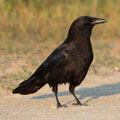
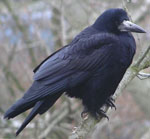

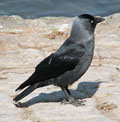
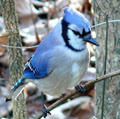

The family Corvidae consists of large passerine birds (order Passeriformes, comprising more than half of all extant bird species).
Corvidae has representatives on all continents except Antarctica, and contains over 120 extant species of crows, rooks, ravens, jackdaws, jays, and magpies (above, from left to right; Madge & Burn 1994). The genus Corvus, the most recently evolved, contains the True Crows (crows, ravens, and jackdaws). The American Crow (Corvus brachyrhynchos) is a familiar constituent, as is Common Raven (Corvus corax, the largest passerine).
Corvids have long been viewed as intelligent by humans and feature prominently in our folklore and mythology.
Some Native Americans, like the Haida nation, believed that a raven created the earth. Odin, the supreme deity of the Norse pantheon, was known as the "raven god" and kept two ravens, one on each shoulder. Curiously, their names were Hugin ("Thought") and Munin ("Memory"), and they whispered tidings into his ears. In a familiar fable by Aesop, a thirsty crow finds a pitcher of water, but it is only half-full and the liquid is beyond the reach of its beak. So, the
crow devises a clever plan: it drops pebbles in, one by one, until the water rises to the top, allowing the crow to drink. Research is beginning to show that this reputation for intelligence is well-founded. In August 2009, a study published in Current Biology revealed that rooks do just the same as the crow in the fable when presented with a similar situation (Bird & Emery 2009).
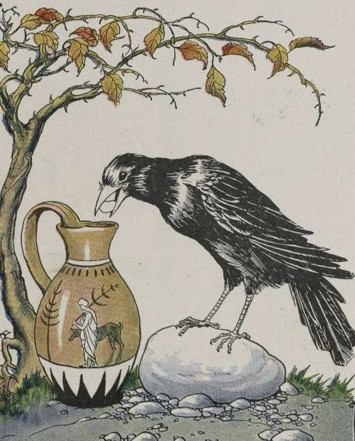
In a 2008 study, European Magpies demonstrated self-awareness in mirror tests; they are the first and only birds to do so
(Prior et al. 2008). The New Caledonian Crow garnered media attention in 2009 and 2010 for its tool-making abilities. It is the only non-human species able to modify existing tools to make new ones and then pass these innovations along to other individuals in the group (Weir et al. 2002). Corvids have also demonstrated the ability to use one tool to affect another tool to achieve a task. Corvids can recall specific past events (Clayton & Dickinson 1998), plan for the future (Raby et al. 2007), imagine another's point of view (Dally et al. 2006), and solve problems cooperatively (Seed et al. 2008); this evidence seems to "fly" in the face of the popular belief that intelligence is Hominidae's exclusive privilege.
What is Intelligence?
The remarkable feats achieved by corvids in recent experiments might lead one to conclude that these birds are intelligent,
but what is intelligence? When two dozen prominent theorists in psychology and learning were posed with the same, they gave two dozen different answers (Neisser et al. 1996). In Mainstream Science on Intelligence (Gottfredson 1997), an editorial by 52 prominent researchers, intelligence was defined as:
A very general mental capability that, among other things, involves the ability to reason, plan, solve problems, think abstractly, comprehend complex ideas, learn quickly and learn from experience... it reflects a broader and deeper capability for comprehending our surroundings—"catching on," "making sense" of things, or "figuring out" what to do.
This definition was meant for hominids (specifically humans), but the above criteria are also met by another, distantly related family of vertebrates-- you guessed it, corvids.
Purpose and Plan:
The purpose of this site is to conduct a comprehensive examination of the existing literature on corvid cognition.
I personally aim to be as exhaustive in scope as possible in order to achieve, in the end, a synthesis of something that resembles the current scientific understanding of this interesting quality these birds possess. I want to learn as much as I can about the topic, and I want to arrange what I have learned in a format accessible to stronger curiosities; to others that feel the same way.
A sort of interactive novitiate review paper is my intention.
To ensure a thorough-going exploration of corvid cognition as it is currently understood, I make use of two scientific frames of reference. The main frame is reflected in the site layout, which follows Nikolaas Tinbergen's "four questions" schema
(Tinbergen 1963). This break-down allows the question of corvid intelligence to be approached from all angles: the evolutionary history of intelligence in Corvidae (phylogeny), the development of this intelligence in an individual's lifetime (ontogeny), the physiological basis for this intelligence and how this intelligence works (mechanism), and lastly, how this intelligence gives these animals an adaptive advantage, increasing their fitness (adaptive value). Much of what it takes to demonstrate the mechanism of cognition, however, necessitates interaction with the environment-- biology in it's present state cannot yet identify the specific neural and genetic underpinnings of such complex behavior. As such, the discussion of mechanism might, at times, sprawl out of schematic bounds.
The other schema was adopted in order to clarify what is meant by "intelligence" here. It is the "cognitive tool-kit" definition of complex cognition, taken from a recent review article in Science that compares the psychology of corvids and great apes
(Emery & Clayton 2004b).There, complex cognition is defined by four components: the ability to identify cause-and-effect relationships (causal reasoning), the ability to act on information flexibly and adjust to new circumstances, to generalize, and to make inferences (flexibility), the ability to consider situations not currently available to perception; to simulate past events in the mind (imagination), and the ability to imagine possible future events (prospection). For simplicity, the "cognitive tool-kit" definition should be considered the touchstone of complex cognition in the discussion that follows. Beyond that, I'm just going to wing it.
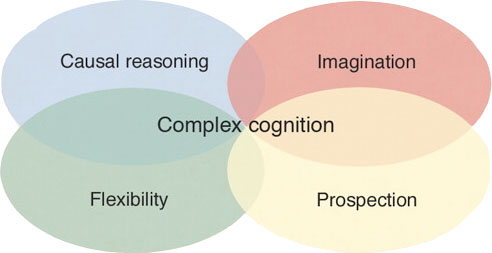
This website was created by Nathaniel Raley for Suzy Renn's Animal Behavior course (BIO 342) at Reed College, Fall 2010